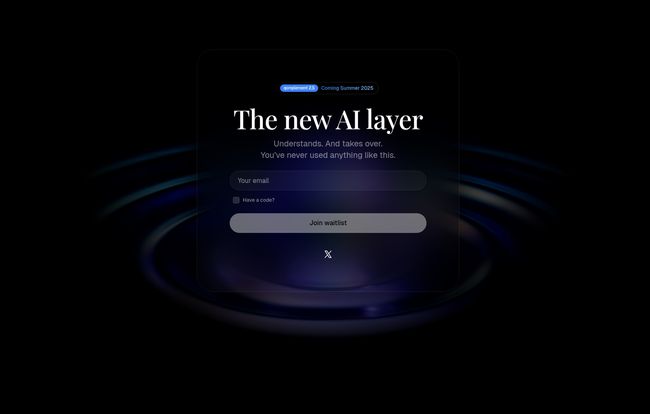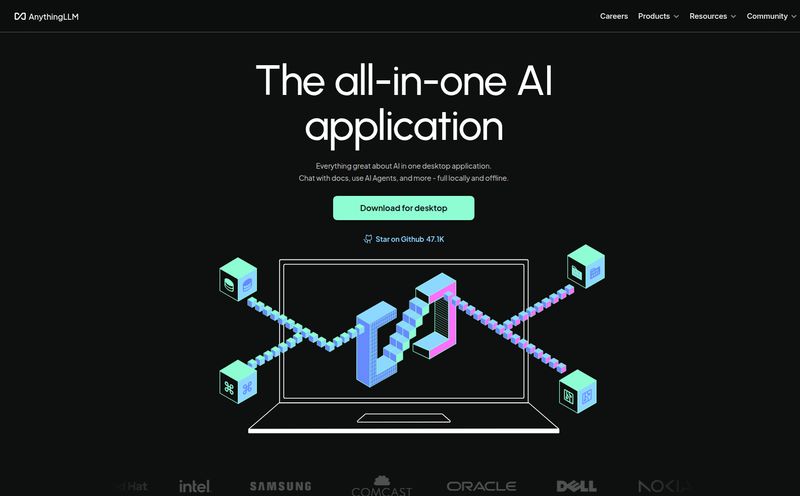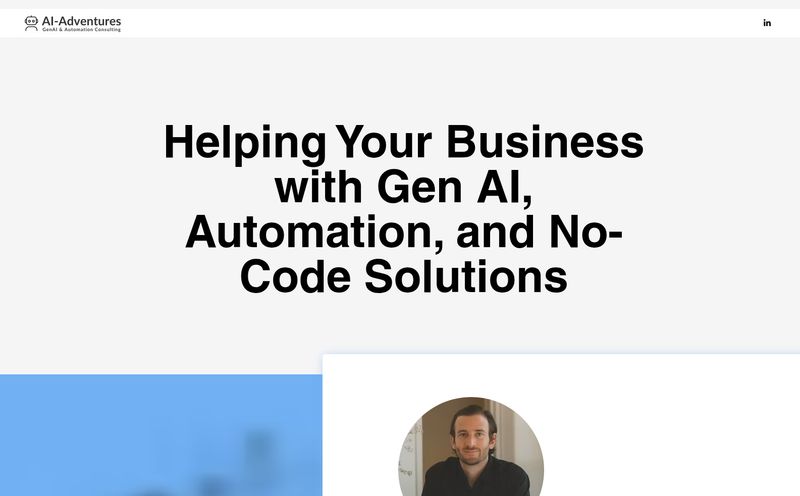I’ve been in the SEO and digital marketing game for a long time. I’ve seen trends come and go, platforms rise and fall, and a whole lot of tools promising to be the “next big thing.” So when I see a landing page with a dark, moody background and a bold claim like “The new AI layer. Understands. And takes over,” my professional skepticism kicks in. Hard.
But then I read a bit more. And a bit more. And the skepticism starts to morph into… well, let's call it professional curiosity. The tool is called qomplement, and it isn’t positioning itself as just another app or a browser extension. Oh no. It claims to be an intelligent agent built right into your operating system. An AI that can watch you work, learn your processes, and then just… do them for you. Across any application. No APIs, no complex integrations, no coding.
Yeah. You read that right. My interest is definitely piqued.
So, What Exactly is qomplement?
Let's break this down. Forget about the automation tools you might be used to. Most of them rely on something called an Application Programming Interface (API). Think of APIs as pre-built bridges that let two different software programs talk to each other in a very structured way. It’s powerful, but if there’s no bridge built between the two apps you need to connect? You’re out of luck.
qomplement apparently just decides to swim across the river. Or build its own damn boat. It doesn’t need those pre-approved pathways. It operates at the OS (Operating System) level, meaning it sees your screen, mouse, and keyboard the same way you do. It learns by observing your actions—you open a spreadsheet, you copy a column of names, you switch to your CRM, you paste the names into a search bar, you update a field. It watches, it understands the pattern, and then it can replicate it on its own.

Visit qomplement
It’s less like a pre-programmed robot following a rigid script and more like a ghost in the machine—your ghost. A digital apprentice who learns your unique, sometimes chaotic, way of getting things done and then takes over the boring bits.
Beyond Zapier: Why OS-Level Automation is a Game Changer
I love tools like Zapier and Make. They are the backbone of so many business workflows, including some of mine. But their biggest strength is also their biggest limitation: the API. You are forever bound by the “triggers” and “actions” the developers decided to make available. You can’t tell Zapier to automate a process inside some obscure piece of accounting software from 2012 that your company refuses to replace. You know the one I'm talking about.
This is where qomplement could fundamentally change the automation landscape. By operating on the visual layer of the user interface (UI), it sidesteps the need for developer-built integrations entirely. It doesn’t matter if the software is a modern SaaS platform or a crusty old desktop program. If you can click and type in it, qomplement can theoretically learn to do the same.
This opens up automation possibilities for countless tasks that were previously untouchable. Think about the hours burned on things like:
- Transferring customer data from an email to a proprietary, non-API-based project management tool.
- Compiling weekly reports by pulling figures from three different desktop applications and putting them into a PowerPoint slide.
- Processing invoices that involve opening a PDF, copying the details, and pasting them into legacy accounting software.
This is the real, unglamorous work that millions of people do every single day. And it’s the work that most modern automation tools simply can’t touch. The idea of an AI that can handle that… it's a big deal.
The Core Promise: How qomplement Works Its Magic
Learning Your Personal Workflows
The secret sauce, as they present it, is in the learning. It’s not just about recording your clicks and playing them back. That's a macro, and we've had those for decades. Qomplement claims to understand the intent behind your actions. It learns the goal of the workflow, which means it can be more resilient to small changes in the UI. If a button moves slightly in the next software update, a simple macro would break. An intelligent agent, in theory, would look for the “Save” button, not just for a button at specific coordinates on the screen.
The Power of Intent-Driven Actions
The founders, Karim & Andres, say, “We are not building a better interface. We are building the new layer of intelligence for how work gets done.” This is a critical distinction. They aren’t selling an app; they’re selling a capability. You don’t program qomplement; you guide it with your intent. You tell it, “Take all the new signups from this spreadsheet and create client profiles for them in our project software.” Then you show it how once, and it takes it from there. At least, that's the promise.
A Glimpse of a Multi-Agent Future
On their site, they also mention something that gets my inner nerd really excited: “multi-agent ecosystems.” This is forward-thinking stuff. Imagine a team where one person’s qomplement agent handles sales lead entry, which then triggers another person’s agent to begin the onboarding document creation process, which in turn signals a third agent in finance to create a new billing profile. All of this happening in the background, across different people's computers, without a single API call. It's a vision of collaborative automation that feels like something out of science fiction.
My Honest Take: The Good, The Bad, and The TBD
Let’s get real. Every new technology has its pros and cons. Based on what we know, here’s my breakdown.
The upside is obvious and massive. Automating tedious tasks saves an incredible amount of time and, by extension, money. It also dramatically reduces the chance of human error from manual data entry—I’ve made enough of those typos in my day to appreciate this. The fact that it works across any desktop app is its killer feature, making it universally applicable.
However, we have to be realistic. The website itself is in waitlist mode, which means we’re in the early days. The first “con” is that there will absolutely be a learning curve. Not a coding curve, but a curve in learning how to effectively “teach” the agent and trust it. Second, performance will likely depend on the task's complexity. A simple copy-paste job is one thing; a dynamic, multi-step process with lots of variables will be a much bigger test. And finally, the limited early access (“Coming Summer 2025”) means none of us can get our hands on it right now, which is just frustrating when the idea is so compelling.
What About the Price Tag?
Here’s the million-dollar question. Or, hopefully, a much more reasonable monthly subscription question. As of now, there is no public pricing information for qomplement. They are currently operating on a waitlist model for their launch in Summer 2025.
If I had to speculate, I’d guess we’ll see a tiered subscription model, common in the SaaS world. Perhaps a free or low-cost tier for individuals with a limited number of automated tasks per month, and then more expensive business or enterprise tiers offering more complex automations, multi-agent features, and priority support. But thats just my educated guess, we'll have to wait and see.
Who is This For, Really?
Initially, I see this being a godsend for roles drowning in administrative work. Data entry clerks, executive assistants, HR coordinators, and accounts payable specialists could see their workloads transformed. But the potential is much broader. Marketing teams could automate social media reporting, sales teams could automate CRM updates, and solo freelancers could automate their entire invoicing and client onboarding process. If you’ve ever found yourself thinking, “I wish I could just hire someone to do this clicking for me,” then you are the target audience.
The Final Verdict: Is qomplement the Future of Desktop Work?
Look, the hype is real. The promise is huge. The idea of an intelligent AI layer that automates the drudgery of desktop work is, without a doubt, compelling. Qomplement represents a conceptual leap away from API-bound automation and towards a more fluid, human-like way of interacting with our machines.
Will it live up to the hype? The jury's still out. The devil is always in the details, and the execution needs to be flawless for a tool like this to gain trust. But am I excited? Absolutely. I’ve already signed up for the waitlist. This is exactly the kind of disruptive technology that could quietly change everything about how we work on a computer. And I, for one, am here for it.
Frequently Asked Questions about qomplement
- How is qomplement different from tools like Zapier or UiPath?
- Zapier and similar tools are API-based, meaning they need pre-built connectors to work. Qomplement is an AI agent that works at the OS level, visually learning and replicating tasks in any application, just like a human would, without needing APIs. It’s more like a personal desktop assistant than a cloud-based app connector.
- Is qomplement safe? Does it send my sensitive data to the cloud?
- While specifics aren't public yet, tools like this typically prioritize security by processing as much as possible on your local machine. The “learning” of workflows would likely happen locally. The intent is for the AI to control your desktop, not to upload your desktop to the cloud. We'll need to see their official security and privacy policy for confirmation.
- Do I need to know how to code to use qomplement?
- No. The entire premise is that it's a no-code solution. It learns by watching you perform a task. If you know how to do the task yourself, you can teach it to qomplement.
- What kinds of tasks can qomplement automate?
- Any repetitive task that you perform on your desktop is a candidate. Examples include: copying data between a spreadsheet and a CRM, generating reports by pulling information from different apps, processing batches of files, filling out online forms, and standardizing data formats.
- When can I try qomplement?
- Currently, qomplement is in a pre-launch phase. You can sign up for the waitlist on their website. The official launch is slated for “Summer 2025.”
- Will it work on both Mac and Windows?
- The goal for any OS-level tool is to be cross-platform. While not explicitly stated, it's highly probable that they are developing versions for both Windows and macOS, the two dominant desktop operating systems, to maximize their market reach.
Reference and Sources
- Official Website: qomplement.ai
- Context on AI Agents: Gartner Hype Cycle for Emerging Technologies (Discusses trends like 'Agentic AI')



